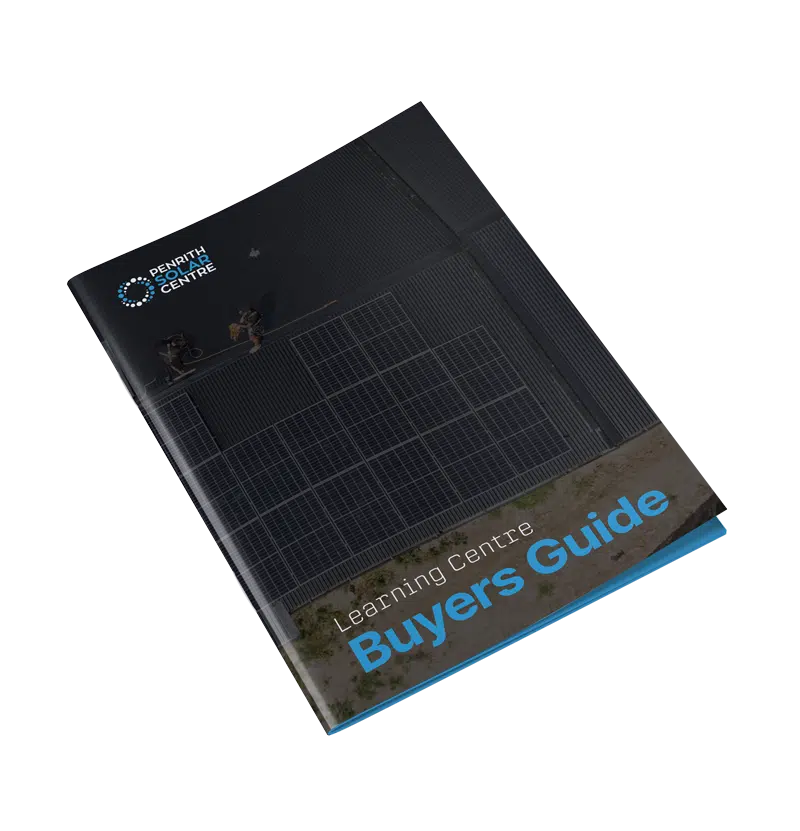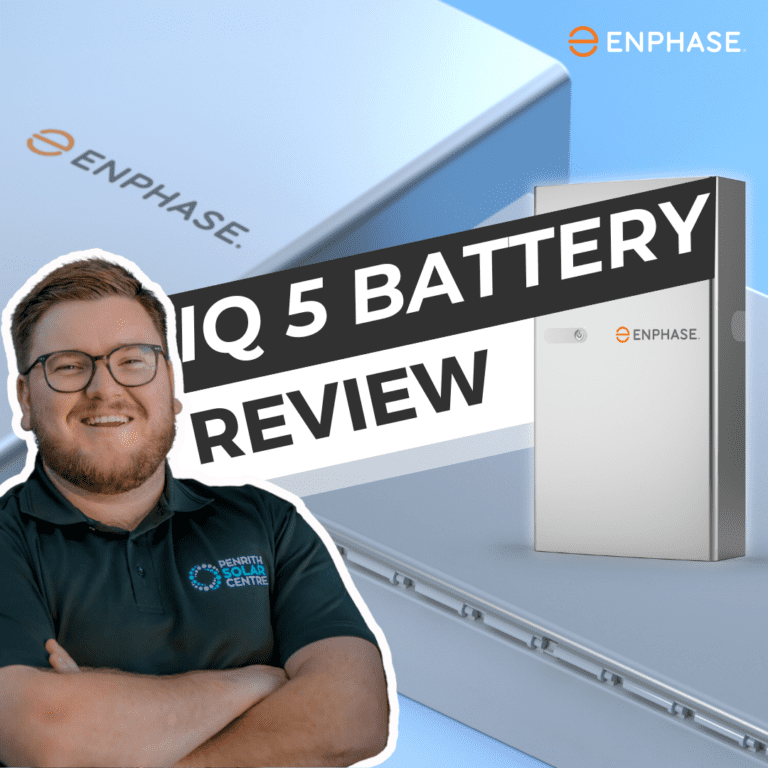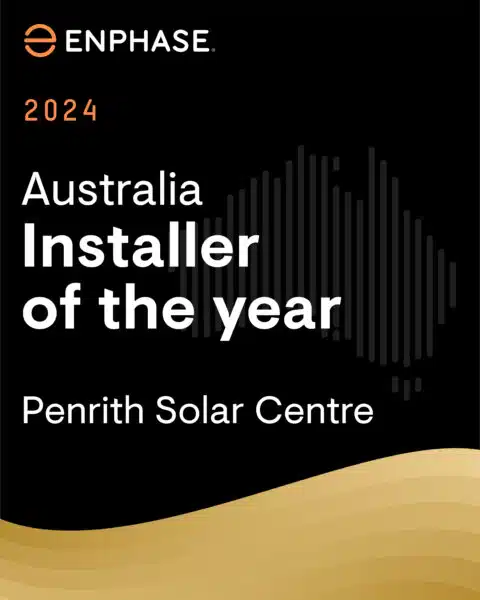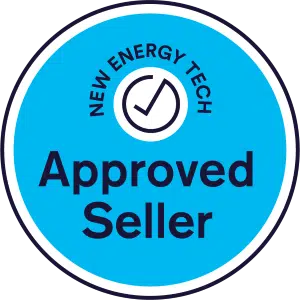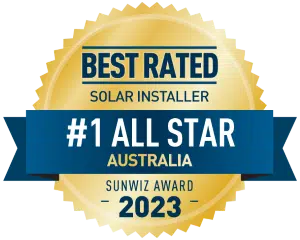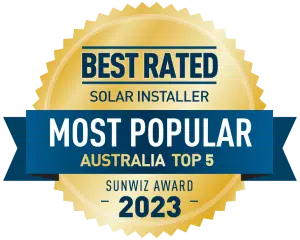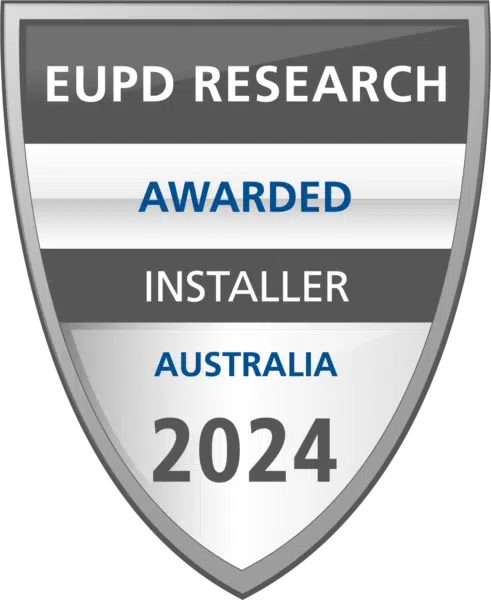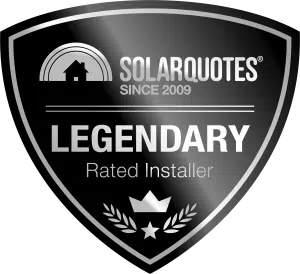
Solar panels are an investment, designed to provide clean, renewable energy for decades. However, inefficiencies can arise due to poor installation, outdated technology, or simple oversights.
At Penrith Solar Centre, we know how these inefficiencies can drastically impact your energy output and reduce your system’s overall effectiveness. This article will outline common causes of inefficiencies, explain how to address them, and provide tips to optimise your solar panels’ performance.
You’ll learn about the following:
- Why Solar Panel Efficiency Matters
- String Inverters vs. Microinverters: What You Need to Know
- The Problem with Mismatched Solar Panels
- Maintenance Tips to Avoid Solar Panel Inefficiencies
- Investing in Smarter Solar Panel Technology
By the end of this article, you’ll have a better idea of what makes an efficient solar system and what to look out for as you’re shopping.
Why Solar Panel Efficiency Matters
Solar panel systems are carefully engineered to capture and convert as much sunlight into usable energy as possible. When inefficiencies arise, they can result in:
- Reduced Energy Generation: Your system will struggle to keep up with your energy needs. This means returning to the grid for energy.
- Higher Electricity Costs: Less energy generation means higher monthly utility bills.
- A Longer Payback Period: Inefficient systems take longer to pay off, delaying the financial benefits of your investment.
Key Causes of Solar Panel Inefficiencies
To get the most out of your panels, it’s crucial to understand the root causes of inefficiencies. Here are the main culprits:
Shading Issues: Even small obstructions, like a tree branch or wire, can block sunlight and lower panel performance. In string inverter systems, shading one panel can affect the output of the entire string.
Incorrect Installation: Poor mounting system placement, improper clamping zones, and loose wiring can all lead to reduced efficiency or even damage. Choosing experienced installers is everything.
Poor Maintenance: Dust, grime, and bird droppings left unchecked can reduce the amount of sunlight your panels absorb. Routine cleaning ensures optimal performance.
If you’re interested in learning a bit more about solar panel efficiencies, you might want to check out the following article titled, How Efficient Are Solar Panels? Shade, Heat, and Seasonal Considerations in NSW, Australia.
String Inverters vs. Microinverters: What You Need to Know
When we talk about efficiency in a solar system, the hero of that equation is the inverter or microinverter. They convert the power your solar panels harvest into usable electricity for the home.
Think of the inverter as a translator: your solar panels speak one language, and the inverter translates it into another for the home to use.
What Are String Inverters?
A string inverter connects multiple solar panels in a series, forming a “string.” This technology has been a standard feature in many older and budget-friendly systems.
While effective in converting DC (direct current) to AC (alternating current), string inverters have significant limitations.
- Key Limitation: They work like Christmas lights. The entire string performs at the level of the weakest panel. If one panel is shaded, dirty, or damaged, the energy output of the solar panels on the entire string is reduced to match the lowest-performing panel.
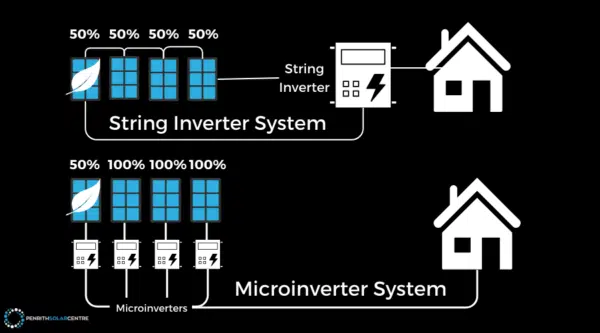
What Are Microinverters?
Microinverters, on the other hand, are mounted beneath each solar panel. Each microinverter is a single-phase inverter that is solely responsible for the output of its panel.
These devices allow each panel to operate independently, maximising energy output. In the solar business, we call this the art of decentralisation.
The Case for Microinverters: Microinverters ensure that one underperforming panel does not drag down the others. This technology is particularly beneficial for roofs with partial shading or panels installed at different angles or different roof faces.
Enphase microinverters are a leading choice for homeowners seeking the highest efficiency from their systems. They perform better long term. They cost more upfront, but they save more money over time.
The Bottom Line
String inverters lag behind microinverters in performance. Homeowners using string inverters may leave valuable kilowatt-hours unused daily. Upgrading to microinverters can dramatically improve your system’s efficiency.
If you’re interested in learning a bit more about how microinverters compare to string inverters, you might want to check out the following article titled, Microinverters vs. String Inverters: A Transparent Comparison.
Ready to go solar? Click here.
The Problem with Mismatched Solar Panels
What Is Panel Mismatch?
Panel mismatch happens when one or more solar panels in a system have electrical characteristics that don’t align, such as voltage, current, or wattage.
Every solar panel is designed to operate at a specific electrical output, and when these characteristics differ, the overall system efficiency suffers.
For example, if you replace a failed panel with one from a different brand or model, even if the panels look similar, their electrical specifications might not match. Wattage is a key factor in this problem.
If the replacement panel generates more or less power than the others in the string, the system will default to the performance level of the weakest panel. This means the higher-wattage panels won’t perform to their full potential, reducing the system’s overall energy production.
Panel mismatch is why it’s essential to use panels with identical or highly compatible electrical characteristics when replacing or expanding your system.
- Why It Matters: Solar panels in a string must have compatible electrical specifications. A mismatched panel can disrupt the flow of electricity, reducing the efficiency of the entire string.
Common Causes of Mismatched Panels
- Replacing failed panels with cheaper or incompatible models.
- Poor installation practices by inexperienced electricians.
Solutions for Panel Mismatch
- Install Microinverters: Panel mismatch isn’t an issue for microinverters where each panel/microinverter combo acts independently of the others.
- Work with a Reputable Installer: Choose an experienced installer who can make sure panels are compatible with each other and avoid mismatched replacements.
If you’re interested in learning a bit more about the benefits of microinverters, you might want to check out the following article titled, What Are the Benefits of an Enphase Microinverter Solar System?
Maintenance Tips to Avoid Solar Panel Inefficiencies
Energy Use Monitoring
Your greatest weapon against solar panel inefficiencies is your energy monitoring app. In the solar industry, we call it a consumption monitoring app because it monitors your energy consumption.
With consumption monitoring, you’re able to keep track of how your solar system and home are using electricity: how much is coming from solar, how much the house is using, and how much you’re importing or exporting from and to the grid.
Enphase microinverter solar systems come with a free app for this purpose. Most string inverter systems are limited in comparison. With panel-level monitoring in a microinverter system, you know the second a panel is underperforming.
It’s a speedometer for your solar system. If you use it, you can make informed decisions about your energy use.
Regular Inspections
Your solar panels work hard every day to provide you with clean energy, so it’s essential to keep an eye on their condition. Conduct regular visual inspections to catch any obvious issues early. Look for dirt buildup that could block sunlight, cracks that might compromise efficiency, or damaged wiring that could pose safety risks.
Cleaning Best Practices
Cleaning your solar panels the right way ensures they stay efficient and avoid long-term damage. Follow these tips for safe and effective cleaning:
- Use Water Only: Skip the detergents, as they can break down the silicon sealant that keeps your panels waterproof. Degraded sealant can lead to water ingress, which causes internal damage and shortens the lifespan of your system.
- Time It Right: Clean your panels early in the morning or late in the evening, when they’re cool. Cleaning during the heat of the day can create thermal shock, which can crack the glass.
- Tools to Use: A soft sponge and hose with a gentle spray setting works best. Avoid abrasive materials or high-pressure washers, as they can scratch the glass or damage the panel’s surface.
Professional Maintenance
While regular DIY checks are great, some issues require a professional’s expertise. Schedule annual maintenance to ensure your system stays in top condition.
Professionals can inspect for hidden problems like microcracks, loose electrical connections, or mounting system instability. These things are easy to miss but can severely affect your panels’ performance over time.
With these practices in place, your solar panels will stay clean, efficient, and ready to maximise your energy production year-round.
If you’re interested in learning a bit more about solar panel maintenance, you might want to check out the following article titled, How to Clean Solar Panels.
Investing in Smarter Solar Panel Technology
As solar technology continues to advance, upgrading your system with smarter equipment can make a noticeable difference in performance and energy savings.
Two key components to consider are smarter string inverters and microinverters, each offering unique benefits depending on your setup and energy goals.
Traditional string inverters have long been the backbone of the solar industry because of their price, but they come with limitations, as we mentioned. However, there’s a new player in the game: the Tesla Powerwall 3, a smarter string inverter.
If you’d like to learn more about Tesla products, we recommend you check out the following article titled, Tesla Powerwall 3 Review: An In-Depth Look at Tesla’s New Solar Battery.
The Case for Smarter Inverters
Smarter string inverters are a game-changer. Equipped with multiple Maximum Power Point Trackers (MPPTs), Powerwall 3 optimises the performance of different panel groups.
By actively adjusting to the conditions of each string, they minimise energy loss and maximise the overall output of your system. Upgrading to a smarter string inverter is an excellent choice for homeowners looking to enhance the efficiency of existing setups without overhauling the entire system.
Consider Microinverters for Maximum Efficiency
For those who want the ultimate in solar optimisation, microinverters are the way to go. Unlike string inverters, this setup allows every panel to operate at its peak capacity, regardless of how the other panels are performing.
Microinverters are especially beneficial for:
- Complex Roof Layouts: If your roof has multiple angles, pitches, or orientations, microinverters ensure that panels on less ideal surfaces don’t hold back the performance of others.
- Shaded Areas: In locations where trees, buildings, or other obstacles cause intermittent shading during the day, microinverters prevent the shadowed panel from dragging down the entire system’s output.
- System Scalability: With microinverters, expanding your solar setup is straightforward. Each additional panel operates independently, making it easy to integrate new components. No panel mismatch.
While microinverters may come with a higher upfront cost, the long-term benefits in terms of energy optimisation and system flexibility often outweigh the investment.
If you’re interested in learning a bit more about how microinverters compare to string inverters from a cost point of view, you might want to check out the following article titled, Cost of Microinverters vs. Cost of String Systems.
Click here to start saving with solar.
Summing Things Up: Wire Efficiency Is Important
Solar panel inefficiencies can arise from outdated inverters, mismatched panels, shading, and poor maintenance practices. By understanding these issues and taking proactive steps, you can optimise your system and energy output.
At Penrith Solar Centre, we partner with you, investing time and resources into maintaining your solar panels. It all starts with a brilliant installation. With the right approach, you can protect your investment and enjoy the full benefits of solar power.
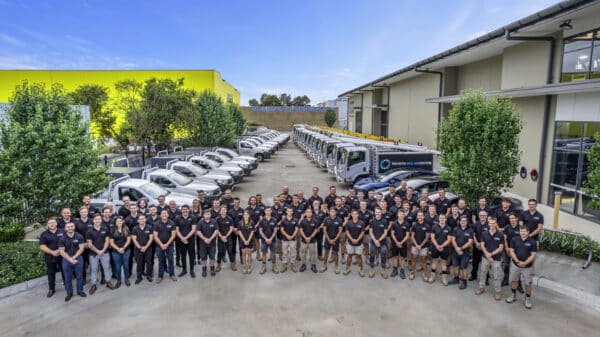
If you’re interested in learning a bit more about the importance of a good installer for your solar (the most important component of any system, seriously), you might want to check out the following article titled, In-house Installers vs. Subcontractors: Which is Better?
